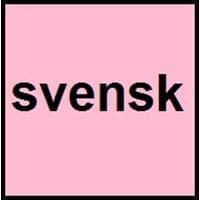Filipino vs Swedish
Countries
Philippines
European Union, Finland, Nordic Council, Sweden
National Language
Philippines
Sweden
Second Language
Philippines
Finland
Speaking Continents
Asia
Antartica, Europe
Minority Language
Not spoken in any of the countries
Australia, Belgium, Canada, France, Germany, Netherlands, Spain, Switzerland, United Kingdom, United States of America
Regulated By
Komisyon sa Wikang Filipino
Institute for the Languages of Finland, Swedish Academy, Swedish Language Council
Interesting Facts
- "Filipino" was officially declared as national language by the constitution in 1987.
- "Filipino" is the official name of Tagalog, or synonym of it.
- In Swedish language, article comes after noun.
- Most of the words in Swedish language began "S" than any other letter.
Similar To
Tagalog Language
Norwegian and Danish Language
Derived From
Spanish Language
Old Norse Language
Alphabets in
Filipino-Alphabets.jpg#200
Swedish-Aphabets.jpg#200
Writing Direction
Not Available
Left-To-Right, Horizontal
Thank You
Salamat
tacka dig
How Are You?
Kumusta
hur mår du
Good Night
magandang gabi
godnatt
Good Evening
Magandang gabi
god kväll
Good Afternoon
Magandang hapon
god eftermiddag
Good Morning
Magandang umaga
god morgon
Please
Mangyaring
vänligen
Sorry
pinagsisisihan
ledsen
I Love You
Mahal kita
jag älskar dig
Excuse Me
patawarin ninyo ako
ursäkta mig
Where They Speak
Philippines
Gabon
How Many People Speak
Not Available
Dialect 2
Hiligaynon
Dialects
Where They Speak
Philippines
Georgia
Where They Speak
Philippines
France
Speaking Population
Not Available
Native Name
filipino
Svenska
Alternative Names
Pilipino
Ruotsi, Svenska
French Name
filipino; pilipino
suédois
German Name
Pilipino
Schwedisch
Pronunciation
[ˌfɪl.ɪˈpiː.no]
[ˈsvɛ̂nskâ]
Ethnicity
Not Available
Swedes, Finland Swedes
Origin
16th Century
13th Century
Language Family
Austronesian Family
Indo-European Family
Subgroup
Not Available
Germanic
Branch
Not Available
Northern (Scandinavian)
Early Forms
No early forms
Old Swedish
Standard Forms
Filipino
Standard Swedish
Language Position
Not Available
Signed Forms
Not Available
Tecknad svenska, ("Signed Swedish")
Scope
Individual
Individual
ISO 639 1
No Data Available
sv
ISO 639 6
Not Available
Not Available
Glottocode
fili1244
swed1254
Linguasphere
No Data Available
52-AAA-ck to -cw
Language Type
Living
Living
Language Linguistic Typology
Not Available
Subject-Verb-Object
Language Morphological Typology
Not Available
Not Available
Filipino and Swedish Language History
Comparison of Filipino vs Swedish language history gives us differences between origin of Filipino and Swedish language. History of Filipino language states that this language originated in 16th Century whereas history of Swedish language states that this language originated in 13th Century. Family of the language also forms a part of history of that language. More on language families of these languages can be found out on Filipino and Swedish Language History.
Filipino and Swedish Greetings
People around the world use different languages to interact with each other. Even if we cannot communicate fluently in any language, it will always be beneficial to know about some of the common greetings or phrases from that language. This is where Filipino and Swedish greetings helps you to understand basic phrases in Filipino and Swedish language. Filipino word for "Hello" is Kumusta or Swedish word for "Thank You" is tacka dig. Find more of such common Filipino Greetings and Swedish Greetings. These greetings will help you to be more confident when conversing with natives that speak these languages.
Filipino vs Swedish Difficulty
The Filipino vs Swedish difficulty level basically depends on the number of Filipino Alphabets and Swedish Alphabets. Also the number of vowels and consonants in the language plays an important role in deciding the difficulty level of that language. The important points to be considered when we compare Filipino and Swedish are the origin, speaking countries, language family, different greetings, speaking population of these languages. Want to know in Filipino and Swedish, which language is harder to learn? Time required to learn Filipino is 44 weeks while to learn Swedish time required is 24 weeks.





